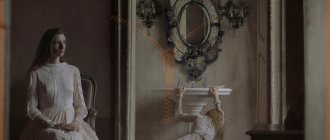Fundamentals of projective diagnostics, purpose
The projective method is based on the creation of special situations in which there are many variations. This type of technique uses incentives. The subject independently develops and supplements them.
For example, he may be asked to complete a particular sentence or complete a drawing. In this case, the answer to the question is not right or wrong, but only allows the specialist to assess aspects of the subject’s personality.
Depending on how the person responds, the doctor identifies possible problems and can determine how to proceed with the patient. For the subject himself, the final goal of projective diagnostics is hidden, so he cannot consciously achieve the desired result.
General characteristics of projective techniques
The word “projection” itself was introduced by S. Freud. He used his techniques to define a type of psychological defense. When a person defends himself from his own hidden desires of an asocial type, he projects (or transfers) them onto the people around him.
Later, projection began to be considered more widely in psychodiagnostics. This concept means how well a person is able to reflect his desires, emotions, etc. Projection refers to behavior as well as views of the world around us.
However, projective techniques differ significantly from other psychodiagnostic tests.
First of all, these techniques:
- They allow you to fully characterize the patient’s personality, rather than highlight any one quality or property.
- The techniques are based on the patient’s experience, as well as on his associative thinking.
- The subject receives complete freedom in his answers.
- Very often creative tasks are considered that allow one to reveal a person’s potential.
Classification by principle of use
Projective techniques in psychology are relatively new and very diverse. The most detailed classification was presented by L. Franclon. He identified 8 types of techniques.
| Type of technique | Description |
| Expressive | The technique helps to study human emotionality. His activities are considered. For this direction, a drawing technique is used. In this case, the test requires the subject to create an image. For example, a specialist may ask you to draw a non-existent animal. |
| Impressive | This technique usually uses cards or pictures. They are objects of so-called stimulus material. These tests allow you to assess a person’s mental state. This technique includes the M. Luscher test. |
| Constructive | During the test, the subject is asked to assign meaning to a particular image. For example, this type of technique includes the Rorschach test. |
| Interpretative | The subject is also asked to look at the images. He must explain the meaning of the pictures and what is happening in them. |
| Constructive | These techniques use figures, pictures, and even a construction set, from which the patient is asked to create logical scenes. After creating such objects, a person must describe them. |
| Cathartic | In this case, the specialist tries to induce a state of catharsis in the patient. This allows us to fully reveal his mental characteristics. Thanks to such methods, a person himself begins to realize his problems and determine their source. |
| Refractive | The specialist pays attention to what reservations or typos the patient makes. Such methods are often used when working with adolescents. |
| Addictive | Addiction is how dependent a person is on a particular activity or behavior. Such methods are used when working with drug addicts, alcoholics and people with other addictions. The doctor assesses what even simpler habits the person has. For example, he may bite his lip, bite his nails, etc. |
Thanks to such a variety of types of techniques, psychologists have a huge arsenal of different tests. However, projective techniques are considered quite controversial by some.
Advantages and disadvantages of projective techniques
Projective techniques in psychology have many positive aspects. Projective surveys and tests can significantly reduce the patient’s anxiety level and diagnose children who cannot yet read. Also, such techniques help to determine a person’s hidden motives, even if he himself is not aware of them.
But some specialists categorically refuse to use projective diagnostics. They argue that such tests give too vague results.
Projective techniques in psychology. Advantages and disadvantages
In such surveys and other applications of the methodology, there is no standard scale that would allow the results to be assessed and classified. The surveys themselves are conducted in an uncontrolled manner. When assessing the results, a specialist, especially if he is inexperienced, may be biased.
Novice psychodiagnosticians do not agree with these shortcomings. They claim that working with such methods is very simple, and thanks to the huge variety of tests, their information content also increases.
Recommendations for the use of projective techniques
Projective techniques are not fundamental in research, even though they are such a powerful diagnostic tool. But if this kind of tests becomes the subject of choice, you need to take into account the features of using projective techniques:
- it is important to comply with all prescribed conditions for the test;
- interpretation must be carried out by at least 3 competent specialists;
- properly selected incentives;
- the chosen methods must correspond to the stated objectives of the study.
Features of application
Projective techniques are widely used in various fields: surveys, pictures and other methods have proven to be very effective in conducting forensic psychiatric examinations. Projective methods are often used when counseling not an individual patient, but a whole group of people; they are often used in employment centers or during personnel changes.
In the process of work, the specialist must take into account the patient’s age and emotional characteristics. The psychologist also pays attention to the mental data of the subject, his social status, marital status and many other factors.
For adults
If an adult is diagnosed, he deliberately tries to choose the best answers. That is, the patient tries to predict the psychologist’s behavior. Thanks to projective tests, it is impossible for a person to determine the best answer, since it does not exist. In the process of work, the doctor can diagnose phobias, frustrations and other deviations.
For children
Projective techniques used in psychology are applicable to children. In this case, images and other types of graphic techniques are used. The psychologist can also invite the patient to draw any animal that comes to the child’s mind. It is much easier to work with such patients, as they behave as sincerely as possible.
For group diagnostics
When working with a large group of people, all diagnostic options are applicable. For example, you can use graphic images and conduct surveys. In this case, the work is carried out according to the principle of a sports team, work or student group. Patients can draw together. Such methods can reduce aggression when working with other people.
Basics and general characteristics
For the first time, the concept of projection as a diagnostic method was used by L. Frank.
The essence of the method is to identify the patient’s projections (associations) to a specific set of images and decipher the results. The person being diagnosed is placed in a situation where he needs to make a series of choices. For each choice, there are several interpretations (decodings), from which a person needs to choose the one that seems most attractive and closest. You can interpret:
- story pictures;
- graphic images;
- abstract images;
- unfinished sentences;
- abstract phrases, proverbs, quotes.
The peculiarity of projective tests is that they have no right or wrong answers. The set of choices is dictated by personality characteristics. The purpose of the study is hidden from the subject, and this makes the testing objective. Without knowing which answers will make the best impression on the psychologist, the subject is inclined to answer truthfully.
Some projective techniques are widely known and accessible even to non-specialists. For example, the popular Rorschach test, the Luscher color test, and the portrait selection test. The results of such studies will be conditional: only a specialist can accurately decipher the data.
Image for Rorschach text
Examples of projective methods
There are several most applicable and popular diagnostic methods.
Rorschach technique (Ink Blot Test)
This technique was developed by the famous Swedish psychiatrist G. Rorschach. She began working on the Ink Blot Test back in the 1920s. This is a projective test, which consists of asking the patient to look at 10 cards on which blots of different shapes are depicted. The images are symmetrical.
The patient must say what exactly he sees in the pictures, more accurately describe what the blots look like. This is an extremely simple and quick test that takes much less time than questionnaires that can have up to 100 questions. The Rorschach test requires a person to give a monosyllabic answer.
The doctor evaluates him according to five main criteria:
- Popularity or originality. Most people see the same thing in the pictures. If 9 subjects say that they see a butterfly, and 10 see a skull, then his answer is considered the most original.
- Content. This is what exactly a person sees in the image: a butterfly, a bird, a fantastic creature, etc.
- Localization. It is necessary to determine the area that the patient was looking at at the time the image was described. Perhaps the subject concentrated on one element of the picture or looked at it in general terms.
- Determinant. We are talking about shape, color and other details that the subject was able to see.
- Form level. It is necessary to assess how well what a person sees corresponds to the image.
After clarifying these criteria, the doctor must interpret the results obtained with the utmost precision. Such a test should only be carried out by a qualified psychologist who has the necessary experience and skills in working with patients.
Cactus
The main purpose of this test is to identify the emotional state of the child. The doctor determines how aggressive he is and to what extent his dissatisfaction is manifested. This diagnostic test is applicable when working with patients over 4 years of age. For the test you need a sheet of paper and a pencil. The psychologist asks the patient to draw a cactus, the way the child imagines it.
After this, the doctor asks the subject a series of additional questions. He should not rush the child; there is no time limit for this test. During the conversation, the psychologist asks what kind of cactus the child drew: wild or growing at home. The patient must tell what the plant will be like when it grows, whether it can be touched, and how to properly care for it.
If a child draws a cactus with a large number of needles, which are long and extend far from the trunk of the plant, then this indicates aggressiveness. If the lines are broken or the patient has been making too much use of the pencil, then this characterizes him as a rather impulsive person.
A self-centered person will draw a large cactus located in the center of the leaf. And if, on the contrary, the plant is very small and drawn in the corner of the sheet, then the child will show dependence and self-doubt. Bright colors in the picture indicate optimism, while dark colors indicate hidden anxieties. If the cactus is located in a flower pot, then this is a sign of the need for protection.
Sondi test
The official name of the test is Szondi-test. This is a type of project technique that was developed by L. Szondi in 1939. During testing, the doctor asks the patient to look at 6 series of photographs, 8 pictures each.
The cards depict the faces of people who suffer from certain mental disorders or diseases. The subject must choose from each series two images that seem least attractive to him.
If a patient selects 4 or more images that demonstrate the same disease, then it is highly likely that he himself suffers from such a deviation. In this case, it does not matter whether the subject has a negative or positive attitude towards such pictures.
Tree
Projective techniques in psychology are predominantly graphic. The Tree test is one of them. It was developed by E. Juckert. The patient is asked to draw a tree, which in psychology is often called a “frozen gesture.” This test has been changed several times over the years.
To complete the test, you must ask the subject to draw any tree that he likes. After this, the doctor also conducts a conversation with the patient, asking questions about the drawn tree. For example, you can specify the type of tree, its age, and height. After this, the specialist tries to evoke associations in the patient.
He asks who the tree looks like. You can even clarify his gender. The tree may have dreams, desires, or, on the contrary, it will be dead for the subject.
The doctor also evaluates the drawing itself. For example, a patient drew a spruce tree with a lot of details, branches, and the needles are very clearly drawn, then this indicates a tendency towards dominance.
Drawing test “Non-existent animal”
This test is recommended when working with teenagers and high school students. This is a fairly simple but very informative test. To do this, the patient needs to be given a piece of paper, a pencil and asked to draw some animal that does not actually exist.
In this case, the patient should not take as a basis the characters of fairy tales or what he saw in a science fiction film. It is important that he comes up with the character himself. The patient must also come up with a name for this animal.
When assessing a drawing, the psychologist also determines its size, location and other factors. For example, the type of lines can indicate a person’s energy. If he presses hard on the pencil, then he is very active, but barely noticeable lines indicate that the patient is constantly suffering from a lack of energy.
It is worth paying attention to the size of the character's head. The greater it is, the more attention the patient pays to the reasonable regulation of his behavior. If he drew an animal with a very small head, then he is guided by fleeting desires, bodily urges.
School of Animals
A similar test is performed when working with children who are just going to school. At this stage, the child experiences problems, but he is not yet able to get out of difficult situations on his own. To work, you need to prepare colored pencils or crayons and a sheet of paper. After this, you need to invite the child to imagine himself in a forest clearing on a sunny day.
In this clearing he should try to see the “School of Animals”. After this, you should ask him to draw all the students and tell them what they do. Next, you need to clarify with the patient what kind of animal he sees himself in this unusual school. At the same time, the child is limited in time. He must determine while the specialist counts to 10.
Having received the answers, the psychologist also evaluates all the drawings and conducts a conversation.
Projective technique “Sentence completion” (for egocentrism)
This technique allows you to assess the level of egocentrism in the patient. This is a study that must be conducted according to accepted standards in psychology. At the same time, the specialist receives a lot of information.
It is worth considering that egocentrism is not a diagnosis, but only an indicator of deeper personal problems. In fact, egocentrism is a symptom of many disorders, such as neurosis or psychopathy.
To carry out the diagnosis, the doctor gives the patient a sheet with 10 incomplete sentences. The subject must complete these sentences as quickly as possible and try not to think about what he is writing. For example, a person must tell what happened several years ago.
When studying the answers, the doctor pays attention to how many times in 10 sentences the patient wrote “I”, “me”, “mine” and other personal derivatives. If the patient uses such words no more than 1-3 times, then he does not have serious problems. Those people who write to themselves in almost every sentence (and this is not the purpose of the test) have great egocentrism.
Projective technique “My holidays”
Projective techniques in psychology allow you to work with patients of almost any age. This test is used by professional psychologists to determine the type of emotional orientation of the patient. The results must be assessed very carefully, so this test is not suitable for beginners. This technique is performed for patients over 10 years of age.
The test is given 15 minutes. During this time, the subject must imagine that all the holidays have disappeared. Now he must come up with a new holiday for every month, 12 in total.
In this case, you cannot use those activities that already exist. That is, the patient must come up with his own holidays and arrange them by month. At the same time, from the name of the holiday it should be clear what exactly is being celebrated, for example, “Dinosaur Day.”
After this, the doctor excludes those options that are too similar to real holidays. The remaining options are evaluated, and the specialist determines the emotional orientation of the subject’s personality using a point system. For each original holiday, the specialist gives 2 points. If multiple holidays fall into the same category, points will be deducted.
Family drawing
This is a test that combines several methods to assess intrafamily relationships. In this case, the images are also evaluated; the work is carried out mainly with children.
This diagnostic technique was first considered by K. Machover in 1949. After that, this testing was constantly refined. Today this technique is also called Wolfe drawing. According to this test, the child is asked to draw sequentially all the members of his family.
The doctor pays attention to the location of people in the picture. The fact that the subject did not draw someone from his family is also taken into account. According to the proportions of the people depicted, you can determine who in the family is the greatest authority for the child.
However, in his works, Wulf did not give a clear formulation and definition of each feature of drawing. Most of all, he paid attention to consistency. That is, the one whom the child drew first is the most important person for him.
This graphic testing system was modified by V. Hules. He suggested analyzing not only the sequence and the finished result, but also the drawing process itself. He paid attention to what emotions the patient experienced while drawing family members.
The most modern version of this research method is based on the graphic quality of the image. The specialist takes into account the lines, the pressure on the pencil, how accurately the drawing is made. It is also important on which part of the sheet the child draws his family: in the middle of the sheet or somewhere in the corner. After this, the formal structure needs to be assessed.
The specialist examines the dynamism of the drawing. The next step is to evaluate the content itself. The doctor may ask the child clarifying questions. For example, he can find out why the patient decided to draw his mother much taller than his father, although in reality the opposite is true.
Additionally, professional psychologists recommend asking provocative questions. The specialist's task is to encourage the child to reveal his emotional state and attitude towards parents, brothers and other family members. To do this, a psychologist can ask who the child is considered the best and worst in the family. Experts also often ask so-called sociometric questions.
This means that the answers to them can only be negative or positive. For example, you can ask your child what he thinks if there is no room in the car for everyone in his family, which members of his family will have to refuse the trip. Ultimately, the psychologist must clearly determine what the child depicted and what the hierarchy in his family is in his opinion. It's important to pay attention to detail.
Modern design techniques are often discussed in psychology. Although some experts do not recommend using such tests, there are those who believe that these techniques are very effective and easy to use. However, in any case, resorting to such diagnostic measures can only be done by studying these methods and their varieties in detail.
Projective techniques in psychology. article on the topic
Projective techniques in psychology
The term “projective” (from the Latin “throwing forward”) was introduced by Lawrence Frank (1939) to unite a whole group of apparently heterogeneous methods of studying personality, involving a person’s symbolic transfer of the content of the inner world to external objects.
Indeed, in various manifestations of the subject’s activity (in creativity, statements regarding reality, individual preferences, etc.), hidden aspirations, unconscious problems, and preferred approaches to resolving contradictions are projected to one degree or another. The researcher’s task is to recreate a situation in which a person’s systems of personal meanings and behavioral strategies reveal themselves to the required extent.
The use of projective techniques involves:
1) unstructuredness, uncertainty of stimulus material, allowing the possibility of being used or interpreted in a wide variety of ways. What comes to the fore is not its objective content, but the associative relationship that manifests itself in the process of acting with it;
2) formulation of instructions in the most general and concise form, leaving significant freedom for self-expression and imagination;
3) creating an atmosphere of goodwill in the complete absence of value judgments on the part of the researcher. There are no right or wrong answers here. A person has the right to answer as he pleases;
4) the subject’s lack of awareness of the diagnostic significance of his actions and words, which allows him to avoid intentional or involuntary distortions in the projection of personality.
As an example, consider one of the most well-known projective techniques. This is the so-called “inkblot test”, developed in the 20s. Swiss psychiatrist Hermann Rorschach (1884-1984).
The stimulus material here is ten images of uncertain configuration, symmetrical about the central axes. Each of them is printed on a sheet measuring 18x24 cm. Five images are black and white, five are color. Something quite similar to them can be obtained if you make a blot inside a paper folded in half so that it is imprinted, without interruption, on the other half. “Rorschach Blots” were selected from many similar ones as the most diagnostic in relation to hidden attitudes and character traits.
The examination is usually carried out in two stages. At the first, a person is asked to look at each leaf and describe what he sees in this or that spot, what it reminds of, what it looks like. In this case, verbatim recordings of statements are made, characteristics of behavior and the time of responses are recorded. At the second stage, the researcher repeatedly presents the same sheets and tries to clarify which characteristics of the image determined the previous answers. During the survey, special attention is paid to the content of the answers (whether the subject sees, for example, human figures, mythological or real animals, geographical outlines, landscapes, sexual objects, etc.), as well as to the localization of significant details in relation to the entire image , on the features of the spot that are identified as significant for associations (color, shape, apparent movement), on the degree of typicality or originality of the answers in comparison with the known array of data.
The answers are analyzed according to special categories, which make it possible to identify the “type of experience”, affectivity and the degree of its controllability, some intellectual characteristics, and the specifics of the dominant defense mechanisms. There are various interpretation schemes (the total bibliography for this method exceeds seven thousand works).
You should know that the interpretation of the results of any projective technique is largely determined by the experience and qualifications of the researcher. Of course, there are instructions on the basic principles of diagnosis, and certain meanings of the test subjects’ behavior options are described in the literature. However, this, as a rule, is not enough for full-fledged research activities. The necessary professional competence is acquired through long-term practice under the guidance of specialists. Therefore, this paragraph contains, mainly, only general information about the specifics of this type of technique.
It is known that projective diagnostics has a number of unique advantages. Firstly, it is focused on unconscious or not fully conscious mental phenomena, on those aspects of personality that are usually hidden from observation. Secondly, the indirect method of addressing the personal characteristics of the subjects does not activate psychological defense mechanisms that can distort the picture of the inner world. Thirdly, the uncertainty of the research situation allows for a wide variety of possible behavioral reactions that experience almost no external pressure. At the same time, the individual characteristics of the individual receive quite adequate expression.
At the same time, projective techniques do not have strictly unified procedures. For example, a researcher behaves completely differently with sociable, active, confident subjects and with those who are timid, withdrawn, and anxious. Thus, the comparability of individual performances of the same task is already violated.
An even more serious problem is the subjectivity of interpretation. Not only the experience and qualifications of the researcher, but also his belonging to a certain sociocultural environment, as well as the characteristics of personal development can lead to significant variability in judgments. An example is the phenomenon known as secondary projection. Its essence is that, being under the influence of his own internal problems, the researcher sometimes plays the role of a “distorting mirror”, that is, he distorts the interpretation, turns out to be more susceptible to some aspects, without noticing others. It is as if he also “imprints” his own personality on the analyzed material.
Experts put forward another critical argument: at present, there is not enough convincing evidence of the validity and reliability of the main projective techniques.
All this does not allow us to talk, as sometimes happens in practice, about “projective tests”. However, it should be noted that in the hands of a knowledgeable psychologist, these techniques become an indispensable means of studying personality. Although, of course, none of them will dare to formulate final research conclusions based on a separate projective technique without verifying its results in other ways.
Projective diagnostics began with the so-called association experiment, developed by the famous Swiss psychologist Carl-Gustav Jung (1875-1961).
Let us recall that the subject is required to respond as quickly as possible to the word presented to him with the first word that comes to mind. Inhibition of the response, misunderstanding of the stimulus word, its mechanical repetition, unmotivated laughter, etc. are considered as indications of the presence of hidden affective complexes.
The fundamental theoretical sources for the development of the projective direction were associationism and psychoanalysis.
The position that the actualization of some mental elements (perceptions, ideas) under certain conditions entails the appearance of other elements was supplemented by the doctrine of the unconscious, which was originally understood as the hidden engine of personality, a set of unrealized drives blindly acting from the depths of the psyche. Projective techniques were considered as a kind of “bridge” from the consciousness of one person to the unconscious of another.
It should be noted that the term itself denoting this group of techniques comes from psychoanalysis. Where, as is known, projection is one of the defense mechanisms, the action of which consists in the unconscious transfer by the subject of his own properties and states to someone around him.
Since the early 40s. In the 20th century, psychodiagnostics using projective means occupies one of the leading places in personality research. Let's consider the main varieties of this direction.
There are many classifications of techniques based on the principle of projection. Let's look at one of the most common.
Traditionally there are:
1. Methods of structuring, which involve giving subjects a certain meaning to the material, endowing it with some content.
In addition to visual symbols similar to the “Rorschach ink blots” described above, this can include, say, the tautophone (S. Rosenzweig, D. Shakov, (1940)). Here the subject is informed that he will have to listen to a recording of a male voice, and is warned about the need to be careful, since it is very inaudible. You need to figure out what exactly we are talking about. In reality, the recording is a repetition of certain series of meaningless sound combinations. In this way, information is collected that characterizes a person in terms of contactability, suggestibility, dominant attitudes towards oneself and others, and the degree of subjectivity of judgments.
Another technique from this group deserves attention - the three-dimensional apperception test (D. Twitchell-Allen, 1947). Its stimulus material consists of 28 three-dimensional objects that do not have a clear shape (from those close to a ball and cylinder to those similar to humans or animals). The uncertainty of forms becomes a condition for the variety of behavior of the subjects. They are required, firstly, to select some of the objects, compose and tell a certain story, illustrating their story with actions with the objects, and secondly, describe what each object is and name it. An interesting version of the technique is when people work with blindfolds placed on their eyes, focusing only on kinesthetic and tactile sensations.
2. Methods of design, creating a whole from individual parts and scattered fragments. Perhaps the most famous of them is the “peace test” (M. Lowenfeld, 1939). To carry out the technique, 232 small bright models are offered (houses, trees, airplanes, animals, people, etc.). The subject’s task is to create a kind of “small world” out of them at his own discretion. When analyzing actions, it is taken into account which objects were selected first, how many of them were used, the area of occupied space, the shape of structures, etc. are determined. The authors of the methodology identified and described several types of approaches to constructing the world, with which the work of specific subjects can be correlated.
Another example here would be the “mosaic test” (M. Lowenfeld, 1929). In it you need to create a random pattern of 465 wooden or plastic squares, diamonds and triangles of various colors. The inability of the subject to create a clearly recognizable mosaic with a clear form serves as an indicator of the presence of certain deviations in personal development.
3. Interpretation techniques that involve the interpretation of events, situations, images.
One of the oldest and most common methods of this group is the “thematic apperception test” (TAT), developed in 1935 by the creator of the theory of personology, Henry Murray, in collaboration with Christiane Morgan.
During the study, subjects are presented in a certain sequence with 20 pictures taken from a standard set depending on their gender and age. All of them reflect rather vague situations that allow for different understandings. At the same time, each picture is aimed at updating a certain type of experience (depression, family conflicts, aggressive reactions, sexual problems, etc.). The subjects are asked to compose a story for each of them, describing the thoughts and feelings of the characters, the course of previous events, and the most likely conclusion of the story. All stories are recorded verbatim, recording pauses, intonations, and expressive movements. Typically, a hidden tape recorder or shorthand recording is used. TAT pictures are usually presented individually. The research procedure takes two days.
During the analysis, it is determined with which “hero” the subject identifies himself, his most important characteristics are identified, among which the leading place is occupied by the needs and characteristics of the influence of the environment (“press”). The combination of these two variables forms a “theme” (hence the name of the technique) or a dynamic structure of interaction between the person and the environment.
According to G. Murray, the content of “themes” consists of the real actions of the subject, what he strives for, what he is not aware of, manifesting in fantasies, what he experiences at the present moment and, finally, the features of the idea of the future. As a result, the researcher receives information about the basic aspirations and needs, conflicts characteristic of a given person, ways to resolve them,
The one that was created in 1945 by Saul Rosenzweig on the basis of his theory of frustration (from the Latin “deception”, “disorder”) is also widely used among interpretive methods.
The stimulus material of Rosenzweig's drawing frustration technique consists of 24 drawings, which depict persons in a problematic situation. One of the characters utters a phrase that describes the essence of the problem that has arisen. There is an empty square above the other character. The subject must give for him any answers that come to his mind. Their content is analyzed in order to identify the type of aggression and its direction (at oneself, at others). The type of aggression differs according to what turns out to be more significant for the subject (obstacles, blaming others, searching for constructive solutions to problems).
4. Complementation techniques that involve completing a phrase or story.
The technique of completing sentences, which is a unique development of the associative experiment, was first used by A. Payne in 1928. In this type of technique, the subject is presented with a series of sentences (such as “I have always wanted...”, “The future seems to me...”, “If I were young again...”). Processing responses allows us to identify the subject’s motives, needs, feelings, system of relationships, etc.
Methods for completing sentences exist in many variants and are actively used in modern psychodiagnostics. Compared to them, those that are focused on supplementing texts are somewhat less widespread. An example of the latter is the so-called “insight test” (E. Sargent, 1944). In it, the subject gets acquainted with a certain set of situations and, putting himself in the place of an active person, answers questions.
It goes like this: “A young man suddenly learns that the girl to whom he is engaged has had a very bad reputation in the past. What did the young man do? Why is this so? How did he feel?
The responses received are analyzed according to three aspects: the nature and severity of the emotional reaction, the type of cognitive manifestations, and the method of conflict resolution.
5. Methods of catharsis, that is, self-expression in conditions of emotionally intense creativity.
The most striking example of techniques of this kind is psychodrama (Jacob Moreno, 1946). It is performed as an improvised theatrical performance in which the subject usually plays the role of himself with the support and empathy of other participants. At the same time, on the one hand, his personal and behavioral characteristics are manifested, and on the other hand, due to affective release, a therapeutic effect is achieved.
There are variants of cathartic techniques where subjects act indirectly, projecting their traits and reactions onto substitute objects. This refers to, say, the “doll test” (A. Voltman, 1951). Here children are asked to act out various scenes with a set of dolls (for example, “a quarrel with a brother”) or put on a play on a given topic.
6. Impression techniques that require choice, preference for some stimuli over others.
In this group, the most widely used is the “color preference test,” known as the “Lüscher test.” Its stimulus material is a set of colored cards. The full version contains 73 cards in 25 different shades. In the short, most commonly used version, there are 8 cards.
In the latter case, the research procedure begins with their simultaneous presentation to the subject. At the same time, he is asked to choose the card that is most pleasant and appealing to him. Then it is put aside. The subject is asked to make one more choice from the remaining ones, etc.
The interpretation of execution is based on the following principles:
a) each color has a certain symbolic meaning (for example, green - confidence, perseverance, perseverance; blue - calm, satisfaction);
b) paired color combinations have their own meanings, more fully reflecting the individual characteristics of a person;
c) the positions of colors in the general row or the order of choices are characterized by functional meanings (for example, the color chosen first reflects the means of achieving a goal (for example, blue indicates a person’s desire to act calmly, without tension...), the color chosen second characterizes the goal of aspirations, etc.) ;
d) rejection of “primary” colors (red, blue, green, yellow), as well as the choice among the first colors of “additional” colors (purple, brown, black, gray) is an indicator of internal trouble, suppressed needs, intense anxiety, stress.
7. Graphic techniques based on independent depiction of objects, people, animals, etc.
Among them, the “finger coloring test” (R. Shaw, 1932, etc.) seems to be very unique, where the subject is offered a wet sheet of paper and a set of paints. The drawing is performed in full accordance with the name of the technique. Upon completion of the work, the subject is asked to talk about what happened. This usually involves collecting a series of images taken by one person. The interpretation is based both on the formal and symbolic characteristics of the drawings, and on the preferences of certain colors, the characteristics of motor reactions, and the statements of the subject. It is believed that the extremely weak structure of the situation creates favorable conditions for self-expression.
In modern psychodiagnostics, “paper and pencil” methods have become widespread. Including “drawing of a family” (W. Wolf, 1947, etc.), “House-tree-person” (J. Book, 1948), “tree test” (K. Koch, 1949), “draw a person” ( K. Machover, 1948), “self-portrait” (R. Burns, 1972) and many others. When analyzing their implementation, we proceed from the assumption that in a drawing a person directly expresses the characteristics of his own personality, which can be interpreted using a system of empirically verified criteria.










